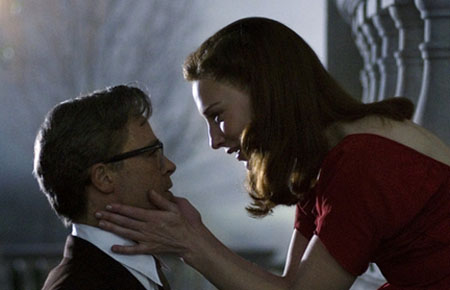“More on the breakthrough side:” Eric Barba on supervising FX in “Benjamin Button”
by
Mark London Williams
Eric Barba has a long, fruitful history with director David Fincher, currently Oscar and DGA-nominated for overseeing writer Eric Roth’s translation of F. Scott Fitzgerald’s novella “The Curious Case of Benjamin Button.” Unlike the eponymous hero, Barba has been moving forward in time with Fincher, since around 2002, working on “a bunch of commercials and videos” together, starting with a particular Addidas ad, where Barba was brought on for some visual augmentation.

The partnership continued through 2007’s “Zodiac,” where the Northern California-raised Fincher, in recapping the grim tale of the S.F.-area serial killer, had Barba help recreate the skyline and look of the 60’s and 70’s-era Bay Area.
“Zodiac” wasn’t perceived as an “FX” picture either — and neither was “Button,” initially, though it finds itself one of three films nominated for a visual effects Oscar. The director “loves the seamless stuff,” Barba agrees, and notes, particularly about this film, that “if anyone goes to the theater and feels it’s an effects film,” then the audience is lost.
Not that Barba has anything against an “FX” film — he’s worked on films like “Supernova” and “The Fifth Element” — but for example, to take the two other films “Button” is competing against for the Academy’s effects statue, “on a superhero movie, you can’t shoot the ‘superhero’ part” without the use of digits and tricks.
“Button” is, ostensibly, a drama — initially a period one: Brad Pitt’s titular character is born “aging in reverse,” starting life, physiologically, as an old man in World War I -era New Orleans, then “aging” in reverse, knowing more, his skin smoothing and sagging less, until he winds up, eventually, as an infant.

Of course, the film is also a meditation on the brevity of life, the gift and seemingly inevitable loss of precious things, etc. And as with most meditations, an interruption can take you right out of the moment.
So how to present Pitt starting believably old, and getting believably younger, while co-star Cate Blanchett takes that same journey in reverse, the way the rest of us do?
There was a combination of techniques, involving motion capture, “digital puppets” to place under actors’ heads, or conversely, the heads digitally placed on other old/young actors’ bodies, to a degree “that had never been done before.” The job, as Barba recounts, was “more on the breakthrough side.”

Adding to his digital tightwire act, Barba also wanted to simply “match (DP Claudio) Miranda’s cinematography,” in terms of letting him light a scene any way he saw fit, as opposed to having the “digital matching” dictate how the lighting should be set.
He wanted Fincher and Miranda to shoot “with guns blazing,” as if this weren’t an effects-heavy picture, staging scenes in baths, with drunken asymmetrical swaying, etc. — anything that might seem traditionally overly-complicated for good shot matching.
That most of the movie was shot using Viper Filmstream cameras helped, as additional cameras — usually a total five (including the “main” one) — were synched to “capture performances in biometric style.”
And while Barba’s house, Digital Domain, had some award-winning tracking software of its own, it still had “nothing that could track those heads in 3-D space.” So they went to the designer of the original software and had him “rewrite code” for these new tasks.
Nor, Barba laughs, did Digital Domain have its own software, prior to this, for hair — that follicle-rich, lighting-variable grail of previous FX work. So that was created as well, all with the knowledge that heads are “difficult to light,” especially if the acting, talking head doesn’t belong to the young or old body it appears to be on, in the film.
“Eyes are crucial,” Barba adds. Especially the way “light moves in the eye socket, and the liquids there.” This also speaks to the je-ne-sais-quois of believable aging effects, as light plays differently over someone young and “bright eyed” than someone older. As with fuller, younger hair, and the older, been-down-a-longer-road wispier variety.

Pitt — especially for the film’s first part, where he starts as an old man, before aging down to middle age and youth — was often in a “gym-style setting,” for his performance capture, which totaled 325 shots just of the head replacement variety (out of over 1100 total FX shots).
“David’s a perfectionist,” Barba says, explaining the complicated production system: Fincher shooting scenes with “body actors” saying lines (and providing sight line matches for later digital use), editing for a few weeks, then coming back and showing them where to put the heads. So to speak.
More traditional FX work was given over to other shops: Asylum FX, for example, handled much of the WWII-era boat/water/battle scenes (somewhat ironic given Digital Domain’s early expertise in “Abyss”-era water effects).
Going in to the project, Barba thought that both “my career — and (Fincher’s) reputation, were at stake.” He hopes that now the bar for “seamless” FX work has been raised , knowing that effects mavens often look at each other’s work and think “if they can do it, we can do it.”
Of course he’s quick to credit Pitt: “It’s Brad’s performance — that’s ultimately the life” of the film. “If an animator had to create (an actor) from scratch, the nuance and timing would be different.”
And you wouldn’t have those can’t-put-your-finger-on-it moments of love, life, loss played out in the quick wince of an eye.
Still, Barba says “I probably have a little more confidence,” after his groundbreaking work on “Button.”
Which is good, as his next project is Disney’s much-anticipated “Tron 2.0” But even in that film, the humans only age in one direction.





